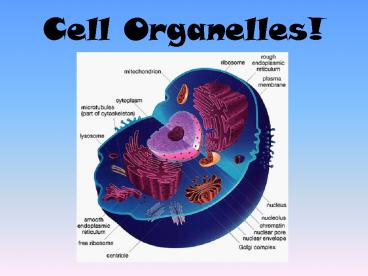Cell Organelles! PowerPoint PPT Presentation
Title: Cell Organelles!
1
Cell Organelles!
2
Organelles
- Specialized subunits of cells that have a
particular function - Prokaryotes have a few (e.g., ribosomes)
- Eukaryotes have many, usually surrounded by a
membrane - This where we get the term Membrane-bound
organelles
3
Cell Membrane
- Also called plasma membrane
- Protects and supports the cell
- Controls what enters and leaves the cell
- It is a lipid bilayer (what does this mean??)
- Found in all types of cells prokaryotes and
eukaryotes!
4
Cell Wall
- Found in eukaryotic plant and protist cells also
in prokaryotes - Main function is protection, rigidity, and
support - Outside of cell membrane
- Made of cellulose (a carb!)
- Allows water and dissolved substances to pass
through.
5
The Nucleus
- Controls most activities in the cell
- Usually one per cell
- Contains DNA the coded instructions for making
proteins and other molecules for the cell - The nuclear envelope has nuclear pores, where
things can enter or leave
See?
6
Nucleolus
- Small, dense region in the middle of the nucleus
- This is where ribosomes are formed.
7
Cytoplasm
- Clear fluid within cell that contains all
organelles - Moves materials throughout the cell
Its the light blue/gray stuff in this picture
8
Ribosomes
- Makes proteins in the cell
- May be free in cytoplasm or attached to ER
- Proteins are vital to life all cells must
produce them!!!
In prokaryotes and eukaryotes
9
Golgi Apparatus (Bodies)
- Stacks of membranes used for storing, modifying,
or packaging (the cells packaging plant!) - Packaged chemicals can be stored inside the cell
or move outside the cell - Cells that make saliva or mucus have many Golgi
bodies
10
Endoplasmic Reticulum
- Series of folded membranes that form sacs or
tubes - Two types smooth and rough
11
Smooth ER vs. Rough ER
- Rough ER
- Ribosomes make it look rough or bumpy
- Ribosomes synthesize (make) proteins, so the
Rough ER is where this happens!
- Smooth ER
- Smooth - no ribosomes!
- Synthesizes (makes) lipids
- Detoxifies drugs
12
Lysosomes
- Made by the Golgi Apparatus
- Full of digestive enzymes to digest unwanted
particles - Help white blood cells to destroy bacteria
- Clean-up crew!
13
censored!!!
14
Peroxisomes
- Filled with enzymes to digest toxic substances
- Numerous in the liver
- Do not form at Golgi Body
15
Vacuoles
- Store food, water, or waste materials
- In plant cells, they are very large!
Vacuoles and lysosomes working together! Amazing!
Astounding!
16
Chloroplasts
- Found in eukaryotic plant cells some protist
cells - Capture light energy and convert it into chemical
energy during photosynthesis
17
Mitochondria
- Energy producers the powerhouse of the cell!
- Convert chemical energy into useable energy
- Found in animal and plant cells
- Many mitochondria in muscle cells why??
- Contain DNA from ovum so all your mitochondria
are from your mom! (Thanks, Mom)
18
Cytoskeleton
- Overlapping network of filaments and fibers that
support the cell and help it maintain its shape - Can also help cells move
- Microfilaments and microtubules
19
Centrioles
- Help to organize the cell during cell division
- They migrate to either side of the cell and help
to pull it apart - Only found in animal cells!
Centrioles are made of microtubules
20
Flagellum
- Extension of the cytoskeleton- Allows movement,
main source of transportation for cells - Only some animals and some prokaryotes have these
21
Cilia/Pili
- Extension of the cytoskeleton- Allows things to
move around the cell. Propels mucus in your
throat, helps with hearing in your ears, and
helps move food particles in your stomach. - Only some animal cells and some prokaryotes
22
Some organelles have their own DNA.
- Two organelles have their own DNA mitochondria
and chloroplasts. - Among multicellular animals, nearly all of the
mtDNA in a fertilized egg is inherited from only
the mother. - One mechanism for this is simple dilution an egg
contains 100,000 to 1,000,000 mitochondria,
whereas a sperm contains only 10 to 100.
23
Endosymbiotic Theory
- Mitochondria and chloroplasts descended from
ancient prokaryotes that developed symbiotic
relationships with ancient cells.
- In other words mitochondria and chloroplasts are
former prokaryotes that now live inside
eukaryotes!
24
More Historic Figures
- 1600s
- Robert Hooke cork cells
- Anton van Leeuwenhoek animalcules
- 1800s
- Matthias Schleiden Father of Cell Theory
- 1900s
- Janet Plowe cell membrane is an actual structure
- George Langford from NC! Breakthroughs in
understanding the cytoskeleton
25
The End
I
Cells!

